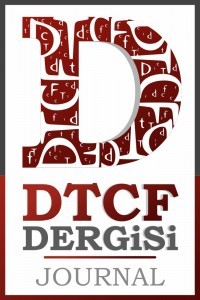RUSÇA VE TÜRKÇEDEKİ ZARF-FİİL YAPILARINDAKİ ANLAMSAL ÖZELLİKLER VE ZAMAN KAVRAMI
Türkçede zarf-fiiller cümlede yüklemin anlamını çeşitli yönlerden etkileyen, fiilden bazı eklerle oluşturulan, şahıs ve zaman belirtmeyen zarf görevindeki kelimelerdir. Rusçada zarf-fiiller ise, şahıs, zaman ve kip kategorileri bulunmayan buna karşılık görünüş ve çatı kategorilerine sahip olan, zarf-fiilin kendi yapısından çok sözcük anlamına ve bağlamına göre çeşitli süreçsel özellikler yansıtan kelimelerdir. Her iki dil için zarf-fiil yapılarına ilişkin yapılan tanımlamalardan hem eylemlerin hem de zarfların özelliklerini barındırmaları açısından bu yapılara ilişkin iki dil arasında benzerlik olduğu görülmektedir. Buna karşılık, bu yapıların kullanım özellikleri daha detaylı incelendiğinde bu yapılara ilişkin her iki dilde farklılıklar bulunduğu görülmektedir. Bu farklılıklar yapısal, anlamsal ve işlevsel farklılıklar olmak üzere üç temel grupta toplanmaktadır. İki dil arasındaki farklılıkların ortaya çıktığı bir diğer alan da eylemler arası zaman ilişkilerde kendini göstermektedir. Zaman anlamı mutlak ve göreceli zaman kavramları çerçevesinde ele alınmaktadır. Bu açıdan zarf-fiillerde zaman kavramının ortaya çıkması iki şekilde ele alınabilir. Birincisi, eylemin gerçekleştiği zaman dilimi içerisinde ifade edilmesi, ikincisi ise, konuşmacının olayı algılayış biçimi şeklinde kendini gösterebilmesidir. Bu bakımdan birleşik bir cümlede ifade bulan zarf-fiilli bir cümlede zamansal ilişkileri belirtmek için belirli bir zaman dilimi kullanılabileceği gibi, zamandan önce veya sonra bir görünüş de kullanılabilir. Bu çalışmada Rusça ve Türkçedeki zarf-fiil yapılarındaki anlamsal özellikler ve zaman kavramı ele alınmaktadır. Çalışmanın amacı bu kavramlar çerçevesinde iki dil arasındaki benzerlik ve farklılıkları ortaya koyarak Rusçadaki zarf-fiil yapılarının daha iyi anlaşılmasını sağlamaktadır.
Anahtar Kelimeler:
Zarf-Fiil, Görünüş, Mutlak Zaman, Göreceli Zaman, Rusça, Türkçe
SEMANTIC FEATURES AND TIME CONCEPT IN GERUND STRUCTURES IN RUSSIAN AND TURKISH LANGUAGES
The gerund in Turkish consists of words which are formed by some verb suffixes and which do not indicate person and time. These words function as adverbs and affect the meaning of the predicate in sentences in different ways. The gerund in Russian language does not have person, time and mood categories, but has aspect category and voice of verb, which reflect the various procedural features according to its meaning and context. Judging by the definitions of the gerund in both languages there seems to be a similarity between the two languages in terms of the features of verbs and adverbs. However, when the characteristics of the use of these structures are examined in more detail, it is seen that there are differences in this structure in both languages. These differences are grouped into three main groups: structural, semantic and functional differences. Another difference between the two languages is time relations between the actions. The meaning of time is considered in the framework of absolute and relative time concepts. In this respect, the concept of time in verbal adverb structures can be considered in two ways. The first is the expression of the action within the time when it takes place, and the second is the expression of the action in the form of the speaker's perception of the event. In this respect, the gerund in the compound sentence can use some time relations in order to express a certain time period to express some time relations, or it can use the aspect before or after time. This study considers the semantic features and time concept in verbal adverb structures in Russian and Turkish languages. Within the framework of these concepts, the aim of the study is to find out similarities and differences between the two languages, and in this way to provide a better understanding of Russian verbal adverb structures.
Keywords:
Verbal Adverb (Gerundium), Aspect, Absolute Time, Relative Time, Russian, Turkish,
___
- Banguoğlu, Tahsin. Türkçenin Grameri. Ankara: Türk Dil Kurumu, 1995.
- Belusov, Vyaçeslav N. ve diğerleri. Kratkaya Russkaya Grammatika. Moskva: Russkiy yazık, 1989.
- Çepasova, Antonina M. ve İrina G Kazaçuk. Glagolı v sovremennom russkom yazıke. Moskva: Flinta, Nauka, 2007.
- Ediskun, Haydar. Türk Dilbilgisi. İstanbul: Remzi, 1992.
- Ergin, Muharrem. Türk Dil Bilgisi. İstanbul: Bayrak,1993.
- Gencan, Tahir Nejat, Dilbilgisi. Ankara, Türk Dil Kurumu, 1979
- Gülsevin, Gürer. “Türkiye Türkçesindeki Birleşik Zarf-Fiiller üzerine.” Afyon Kocatepe Üniversitesi Sosyal Bilimler Dergis. 2 (2001): 122-143.
- Hengirmen, Mehmet. Türkçe Dilbilgisi. Ankara: Engin, 2015.
- Korkmaz, Zeynep. Türkiye Türkçesi Grameri - Şekil Bilgisi. Ankara: Türk Dil Kurumu, 2009.
- Novikov, Lev A. ve diğerleri. Sovremennıy russkiy yazık: Uçebnik: Fonetika, Leksikologiya, Slovoobrazovanie, Morfologiya, Sintaksis. St. Peterburg: Lan, 2003.
- Üstünova, Kerime. Eylem işletimi. Bursa: Sentez, 2016.
- Şeka, Yuri V. Praktiçeskaya grammatika turetskogo yazıka. Moskva: Vostok-Zapad, 2007.
- Yayın Aralığı: Yılda 2 Sayı
- Başlangıç: 1942
- Yayıncı: Ankara Üniversitesi
Sayıdaki Diğer Makaleler
BİR DİS/ÜTOPYA OLARAK POZİTİVİZM KARŞISINDA FARKLI BİLİMSEL YAKLAŞIMLAR
RUSÇA VE TÜRKÇEDEKİ ZARF-FİİL YAPILARINDAKİ ANLAMSAL ÖZELLİKLER VE ZAMAN KAVRAMI
İSTANBUL ÖĞRETMENLERİNİN BURSA SEYAHATİ VE MUSTAFA KEMAL PAŞA'NIN BAŞÖĞRETMENLİĞE GEÇİŞ KONUŞMASI
İSTANBUL'DAKİ HALK KÜTÜPHANELERİNİN OKUL ÖNCESİ DÖNEM ÇOCUKLARA UYGUNLUĞUNUN DEĞERLENDİRİLMESİ
Asiye KAKIRMAN YILDIZ, Bahattin YALÇINKAYA, Varol SAYDAM
SERGEY DOVLATOV'UN ESERLERİ ÇERÇEVESİNDE RUSÇADA ÖRTMECELER
I.ULUSAL MİMARLIK DÖNEMİNİN ANKARA'DA BİR TEMSİLCİSİ: HARİTA UMUM MÜDÜRLÜĞÜ BİNASI
MALTA DİLİ ÜZERİNE TARİHSEL BİR BAKIŞ
KULA'DA BULUNAN BİR GRUP KARAMANLICA MEZAR TAŞI ÜZERİNE TESPİTLER
